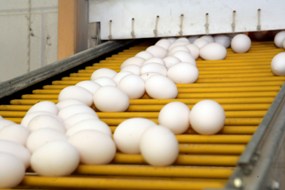Egg shell quality: First looks count

Opening a carton of eggs to find them dirty or broken is a bad advertisement for egg producers. For hatching eggs this counts even more. Being proactive is the best way to avoid this situation. To this end, nutrition can play a significant role. A qualified nutritionist can easily detect problems and suggest remedies to reduce the number of objectionable eggs.
By Ioannis Mavromichalis , International Consulting Nutritionist, Madrid, Spain
The quality of egg shell is important not only for the fresh-egg industry, but also for the hatchery sector. A clean, well formed egg, without visible cracks, spots, or other deformities ensure high acceptance by consumers. In addition, a high quality shell enhances the chances of producing a healthy chick from each egg. Thus, when it comes to eggs, first looks do count for more than one good reason.
There are many factors affecting shell quality, including genetics, health status of the animal, environmental stress, management issues, facilities, handling and of course, nutrition. If certain principles in diet formulation are not followed, nutrition can be the causing factor for some egg shell quality issues. But, in most cases, proper nutritional intervention can ameliorate egg shell quality problems caused by other stress factors, unrelated to nutrition. We shall next examine the two major areas of egg shell quality issues as affected by nutrition.
Dirty eggs not acceptable
Obviously dirty eggs, contaminated with bird excreta, are not acceptable by consumers, as they pose a health risk. In addition, a dirty egg harbours enough bacteria on its surface to impair the health of a hatching chick, reducing thus hatching rate success.
Obviously dirty eggs, contaminated with bird excreta, are not acceptable by consumers, as they pose a health risk. In addition, a dirty egg harbours enough bacteria on its surface to impair the health of a hatching chick, reducing thus hatching rate success.
Dirty eggs are usually caused by digestive issues that lead to sticky droppings. This is a result of dietary composition choices. For example, certain cereals, with rye being the most offensive in this aspect, contain high levels of non-starch polysaccharides that increase digesta viscosity. This invariably leads to sticky excreta that contaminates eggs. This issue can be easily resolved by reverting to less offensive cereals, such as maize or wheat, or by reducing the amount of ‘offensive’ cereals. In addition, there is some evidence suggesting a reduction in sticky droppings when certain non-starch polysaccharide enzymes are added in diets containing these offensive cereals (Table 1).
High water concentration
Another reason for dirty eggs is the problem of having wet droppings (a kind of diarrhoea). This is mostly caused by disease or environmental stress, but certain nutritional factors can aggravate the situation.
Another reason for dirty eggs is the problem of having wet droppings (a kind of diarrhoea). This is mostly caused by disease or environmental stress, but certain nutritional factors can aggravate the situation.
For example, feed or water high in mineral salts, and particularly sulphur salts, can cause excessive water secretion in the gut resulting in a high water concentration in the excreta. Conversely, factors leading to high water intake, including high dietary protein levels and salt, may also lead to wet droppings. When certain ingredients high in simple sugars are used in formulation (for example, bakery meal can have up to 25% sucrose), then this can also lead to this problem. Quite often, knowing the causative factor is enough for professionals to remedy the situation.
In other cases, an intervention strategy is needed (for example, when there is no way to alter the source of drinking water!). Here, certain additives can play a strong role. There are two types of additives suitable for this problem: absorbents that trap water inside the gastrointestinal track and thus reduce the amount of free water, and osmoregulators that cause reversal of excessive water secretion from the gastrointestinal epithelial cells. As usual, a combination works better than any ingredient alone. Fortunately, such ingredients are not expensive and they can be used with relatively good results.
Cracked eggs even worse
A broken or even cracked egg is even more unacceptable for either consumption or hatching purposes. Sometimes, eggs are deposed without any visible cracks, but due to integral weakness of the shell structure, cracks appear during post-depositing handling (cleaning, packaging, moving in crates, etc). Thus, weak eggs are an important issue for all parties involved in the egg industry. It is estimated that about 7% of eggs will end up cracked at some point, but there are cases where this can increase dramatically. Here, nutrition can be of assistance.
Nutrition plays a huge role in egg shell strength because the shell is composed of 94% CaCO3. The source of this compound is of course dietary calcium, reaching the egg either directly from feed or through the bones (usually when the hen rests). As most of the egg shell is formed during the darker hours of the day, and because using calcium from bones is not considered to be in the hen’s best interest, it is imperative to keep calcium absorption from the gut going almost throughout the entire day (or as long as possible).
For this purpose, it is strongly recommended for the major source of dietary calcium (limestone, oyster shells, or calcium carbonate) to be fed as a mix of 1/3 finely ground particles (for immediate absorption) and 2/3 coarsely ground particles (for prolonged absorption). Having all-fine or all-coarse particles always leads to sub-optimal shell strength.
Ideal calcium concentration
Unfortunately, calcium absorption efficiency from the gut diminishes with age. To this end, it would be logical to assume that higher dietary calcium specifications would be warranted for older hens. However, a high calcium concentration, that is beyond a certain point, tends to reduce absorption efficiency by itself; so increasing dietary calcium concentration has its upper limits. The ideal calcium concentration is 4.1 grams/kg feed when feed allowance is 110 grams per hen per day (both very typical values).
Unfortunately, calcium absorption efficiency from the gut diminishes with age. To this end, it would be logical to assume that higher dietary calcium specifications would be warranted for older hens. However, a high calcium concentration, that is beyond a certain point, tends to reduce absorption efficiency by itself; so increasing dietary calcium concentration has its upper limits. The ideal calcium concentration is 4.1 grams/kg feed when feed allowance is 110 grams per hen per day (both very typical values).
Beyond that, we can only attempt to enhance the efficacy by which calcium is being absorbed. The main method is the inclusion of organic acids and (or) extra vitamin D or the vitamin D metabolite 25-OH-D3 (also called calcidiol), all of which have been shown to improve the calcium status of the animal resulting in improved shell calcium deposition (see Table 2). Here it should be noted that Fusarium toxins are known to effectively bind dietary vitamin D3, and thus, the problem of mycotoxins should be addressed before attempting to improve egg shell strength by other means.
Finally, one more way to ensure maximal calcium absorption is to ensure the diet contains no excess phosphorus (no more than 0.3-04% is required). Excess phosphorus binds calcium in the gut resulting in the excretion of both minerals, simply polluting the environment.
Covering dietary requirements
It should be also noted that manganese, always found at high levels in the shell, should be present in adequate levels (50-100 ppm) in the diet throughout the life of the hen. A manganese deficiency is characterised by a rough shell texture and sporadic diaphanous spots. During shell formation, the hen produces HCO-3 that is being used for the synthesis of CaCO3 to be deposited in the egg shell matrix. If the level of dietary anions, such as Cl-, is excessive, the organism reduces the production of HCO-3 to maintain its acid-base balance. This leads to insufficient CaCO3production and consequently to a weak egg shell. To avoid this issue, diets for laying hens should be supplemented with NaCl (common salt) up to the level of covering the dietary requirements for Cl, using other sources to meet the remaining needs for Na. In addition, when saline water is used, the contribution of Na and Cl from water should be taken into account along those from dietary origin. In total, the Na:Cl ratio should remain within the recommended levels as calculated below:
It should be also noted that manganese, always found at high levels in the shell, should be present in adequate levels (50-100 ppm) in the diet throughout the life of the hen. A manganese deficiency is characterised by a rough shell texture and sporadic diaphanous spots. During shell formation, the hen produces HCO-3 that is being used for the synthesis of CaCO3 to be deposited in the egg shell matrix. If the level of dietary anions, such as Cl-, is excessive, the organism reduces the production of HCO-3 to maintain its acid-base balance. This leads to insufficient CaCO3production and consequently to a weak egg shell. To avoid this issue, diets for laying hens should be supplemented with NaCl (common salt) up to the level of covering the dietary requirements for Cl, using other sources to meet the remaining needs for Na. In addition, when saline water is used, the contribution of Na and Cl from water should be taken into account along those from dietary origin. In total, the Na:Cl ratio should remain within the recommended levels as calculated below:
(Na% x 34) / (Cl% x 23) = 2.5 – 3.0
Enhancing calcium absorption
One more causative factor for week egg shell is that of high temperatures. To this end, feeding vitamin C during the summer months has been shown to improve egg quality. Vitamin C can be added either in the feed, or more effectively, it can be administered via the drinking water. Finally, one often neglected factor that affects egg shell strength, is that of its size (weight). Hens deposit more or less the same amount of calcium (about 2 grams per egg) regardless of egg size. Thus, larger eggs are inherently weaker. When measures are taken to increase egg size, such as for example by increasing dietary methionine, care should be taken to avoid any other cause that would reduce calcium availability for the formation of the egg shell. In fact, calcium absorption should be enhanced as much as possible.
Join 31,000+ subscribers
Subscribe to our newsletter to stay updated about all the need-to-know content in the poultry sector, three times a week. Beheer
Beheer








 WP Admin
WP Admin  Bewerk bericht
Bewerk bericht